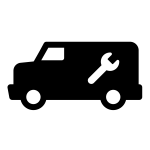Upon completion of the project, our partner in the field reports...
Community Details
This well was broken down and out of use for the last 18 years! You'd have to go all the way back to 1996 to find someone pumping clean water from this pump. It was created by USAID back in the mid 1980's and there are only a few of these original wells in the Sud-Ouest area, none of which are operating. Difficulty with this project was related to the age of the pump and platform. In order to install a new India Mark II pump the team had to first remove all of the old materials. It was very difficult to unscrew rods and pipe, and even to lift off the old pump base. After removing these parts, it was even more difficult to break out the old pump base bolt brackets because they did not correspond with the new Indian Mark II pump being installed. The concrete was very hard but finally replaced with a solid new base bolt bracket. This new rehabilitated well serves 120 families in Gnimbare whose residents were formerly dependent on a water source that was unreliable, which dried up during the dry season and hand –dug wells which were left open and shared with livestock. Gnimbare is a remote village that is difficult to access and whose people are dispersed over farming lands. Their primary activity is agriculture and small animal husbandry. There is a women's association and cotton producers association but other than that, there are no other organizations or activities in the village. Though during the well rehabilitation, the community assembled a water user committee comprised of 4 men and 2 women who assisted the team with the project, supplied any materials they had available and have committed to maintaining the well after the team leaves the area. Not even a school or medical clinic. Gnimbare is home to 500 people. After explaining Living Water’s process for local collaboration, the community was more than pleased to participate in the project by constructing a protective wall around the well platform, constructing a drainage canal, water trough, and soak pit. They did all of this with their own hands and their own resources before the team ever installed one new pipe. This was such a beautiful project, one that was desperately vital. This well, which was originally created by USAID in 1986, had been broken and left idle the past 18 years and speaks volumes for the need of this community.
Hygiene Promotion
During the hygiene education, the Living Water team addressed the following principle issues with 77 people: 18 men, 25 women, and 34 children participants: Germs, hand washing-proper techniques and water saving methods, good-bad hygiene behaviors, proper care of the pump and keeping the water clean. All of these lessons are taught in a participatory method to help community members discover ways to improve their hygiene and sanitation choices, and implement community driven solutions.
"The hygiene training helped us a lot. It's opened our spirits and permitted us to escape many illnesses and diseases, which are in dirty water of which we were ignorant. The village is ready to place all your lessons of maintenance and hygiene in practice. Now we understand that hygiene is a weapon to help us battle our sickness!" - Encouraged Participant
Community Member Interview
Community member, farmer and housewife Marcelline, shared her excitement over the improved water source! "In our quartier here we have suffered from lack of clean water. Every year it happens that the men of this quartier must descend during the dry season to dig a large hole in the dry creek area. We have drunk water from traditional hand dug wells for more than 18 years. We have lost lives of our families because of this water that falls from the first rains. Today our pump is repaired! We are full of joy because clean water has returned in our village! We praise God and I believe that Jesus Christ is in the heart of everyone who is here present."
 Well Rehab
Well Rehab Rehabilitation Project
Rehabilitation Project












